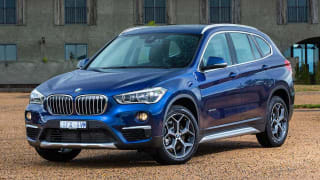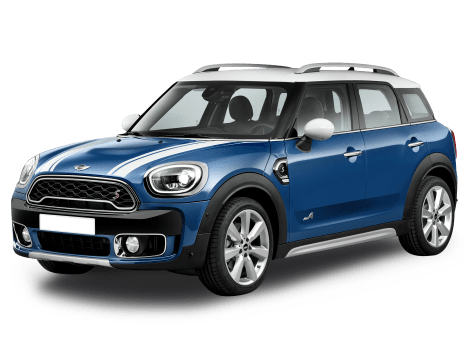
BMW X1 sDrive 20i 2016 review
Peter Anderson road tests and reviews the 2016 BMW X1 sDrive 20i SUV with specs, fuel consumption and verdict.
Browse over 9,000 car reviews
Peter Anderson road tests and reviews the new Mini Countryman with specs, fuel consumption and verdict at its International launch in England.
Mini's first generation Countryman was released in 2011 amid the usual howls about it being too big for a Mini, as though a 21st century car for a global market could get away with being unfeasibly tiny. It turned out customers wanted it, too - the Countryman accounts for around a third of total Mini production.
The car was a smash-hit in the US and Europe, while being a bit more of a sleeper here in Australia - it's best year saw the Countryman take just over 22 percent of total Mini sales (2014, if you're interested), down to fourteen percent of Mini sales in 2016.

The new car is even bigger, stretching the patience of the howlers yet further, delivering a bigger cabin and more space. The one thing you could say about the Countryman is that it still felt like a Mini, Just Bigger.
This new one really needs to hold on to that if the Countryman is to fulfil its role as a car to keep people with the brand as their lives change, as well as nabbing new buyers.
Unfortunately, we don't know a lot about the pricing yet - Mini Australia still hasn't finalised the dollars - but the cars are on the docks, so it can't be too far away. What they would tell us was the entry-level Cooper will be at or around $40,000, which is a significant jump from the old car's sub-$35,000 start.
To make up for that, Mini Australia assured us there'll be a big lift in specification. The range is down to four cars - the entry-level Cooper can be had with the 1.5-litre turbo three cylinder or a 2.0-litre four-cylinder diesel, both in front-wheel drive (FWD) only. The petrol Cooper S is also FWD, while the sole all-wheel drive (AWD) model is the Cooper S D. Automatic transmissions are standard (Six-speed in the Cooper petrol, eight-speed for the rest of the range) and you can have a manual as a no-cost option.
The new rear seats are much more spacious and you could get away with three adults across the back for headroom.
Interestingly, the historical average spend on Countryman options is between $3500 and $4500, so the jump in price is probably not the obstacle it first appears.
As always, there's an options list as long as your arm for the usual decals, interior and exterior customisations, and a dizzying number of lifestyle things. During the launch we spied a pop-up tent on the roof of one car. Our car had the clever picnic bench - lift up the boot floor, grab the tab and out folds a nice soft pad for your backside, and you can shelter under the high-opening tailgate.
Frustratingly, the otherwise excellent entertainment and sat nav control system (very obviously based on BMW's iDrive) still doesn't have Apple CarPlay or Android Auto. The Countryman has a new evolution of the software that looks less naff than that currently offered in the hatch.
Front seat occupants enjoy two cupholders and rear seat passengers now get the same. The doors each take a bottle, bringing the 2017 car up to the standard of the 1959 original, which was specified with pockets to hold a bottle of gin. Those crazy English middle classes.
The back seats slide, letting you balance boot space with legroom.
As the Countryman shares a platform with BMW's rather good X1, the new rear seats are much more spacious and you could get away with three adults across the back for headroom, less so shoulder room.
The back seats slide, letting you balance boot space with legroom. With the seats all the way back, boot space is 450 litres (double, say, a Mazda CX-3's, and bigger than cheaper small SUVs from Honda and Nissan). Drop the seats and you'll have up to 1350 litres and a good flat loadspace. There's further storage under the boot floor, as well as various slots and bins around the cabin.
Yeah, it's a big Mini. The new car isn't a major departure from the first one, maintaining the same proportions for the higher riding five door bodyshell. It doesn't look that much bigger, but it is - 20cm of extra length isn't mucking about in the car world and it's not something that's generally easy to hide.
Part of the trick to hiding that is an increase in wheelbase of 7.5cm, which also means more interior space, especially for rear seat passengers. The other part of the trick is running some fairly big wheels to visually shorten the car.
Crucially, it feels like a standard Mini when you're sitting in the front seat.
The updated look certainly won't scare off current Countryman owners while looking reassuringly part of the Mini family. The headlights are a more mature, squared-off shape with integrated LED driving lights, framing the trademark Mini grille. Not much has happened at the back, just the number plate moving up from the bumper into the tailgate.
Inside is a vast improvement. The dash is a toned-down version of the Mini hatches, with subtle differences in design and material. The perfect descriptor for the Countryman's interior is 'more subdued.' It still has that polarising central roundel with the inset screen for sat-nav and entertainment. The dash pack is also a little more conventionally mounted, but its still circle-based. Some models also have the blade-style head-up display.
Crucially, it feels like a standard Mini when you're sitting in the front seat - that same panoramic view interrupted by the thick, unusually vertical A pillar.
The Countryman range (before the John Cooper Works arrives mid-year) consists of four engines, two petrols and two diesels. The base Cooper's petrol engine is the BMW Group's 1.5-litre turbocharged three-cylinder, developing 100kW/220Nm, mated to either a six-speed manual or six-speed auto. A Cooper with either transmission will crack the 0-100km/h sprint in 9.6 seconds.
The 2.0 diesel Cooper D is the first variant in the range to get the eight-speed automatic, the engine developing 110kW/330Nm. The D is quicker to 100km/h by well over half a second, with the benchmark time dipping below nine seconds for both transmissions, the power reaching the road via the front wheels.
Stepping up the to Cooper S petrol brings a 2.0 turbo and a power jump to 141kW/280Nm. The 0-100km/h times are down by two seconds, the manual coming in at 7.5 seconds and the eight-speed auto a tenth quicker.
The Countryman immediately feels much tighter than the old car.
The Cooper SD All4 sports a more powerful version of the 2.0 diesel, almost matching the Cooper S petrol at 140kW but obliterating it on twist, with 400Nm. It's the only All4 version available in Australia and will motor you from rest to 100km/h in almost identical times to the front drive petrol Cooper S.
The car we drove, which isn't in the Australian lineup, was the petrol Cooper S All4 auto, with the same power outputs and a 100km/h sprint time of 7.2 seconds.
The Countryman is rated to tow between 700kg unbraked and 1700kg braked.
BMW claims the Cooper petrol will average 5.7L/100km on the combined cycle while the D will get around 4.5L/100km.
The Cooper S will average around 6.3 (the auto is slightly better) while the SD All4 will return a tick under or over 5.0L/100km, depending on transmission.
Mini chose the car's spiritual home of England (the Countryman is actually built in the Netherlands), to launch the new car. We drove a mechanical specification that we won't get in Australia - a petrol Cooper S All4. The roads were slippery and muddy and hugely entertaining, with some wacky off-camber corners, bumps and steep blind crests along with charming old hump bridges you could get air over if you threw caution to the wind (we didn't, obviously).
British B-roads are tremendous fun, and when you throw in constant drizzle and fog, they're also quite challenging. Oh, and the huge trucks on narrow green lanes and pensioners staggering about in Toyota Aygos and Renault Scenics added to the obstacle course nature of the drive program. I was in heaven.
The steering is contemporary Mini, with sharp response and excellent weighting.
The Countryman immediately feels much tighter than the old car. Gone is the inconsistent ride - no doubt helped by the longer wheelbase - and it handles dips and bumps a lot more fluidly than the old car, which had a habit of hitting the stops at speed. We were reminded that we weren't riding on run-flats, which all Australian-delivered Countrymans will wear, so we'll have to reserve final judgement until a local drive.
The steering is contemporary Mini, with sharp response and excellent weighting, although a bit more feel from these tyres would have been welcome, but we didn't get much proper dry running.
The car is also a lot more refined, with tyre roar and engine noise much better damped, with easy conversation flowing between front seat passengers as well as those in the back.
The Cooper S's petrol engine is a free-spinning fun machine, with a good, clean power delivery that we're already very familiar with from the Cooper S hatch. The eight-speed transmission is also very good, and a diversion onto a muddy rutted track at the event's base in Buckinghamshire showed the All4 system to be very competent on extremely slippery surfaces. The route wasn't super-challenging, but most other small SUVs would struggle.
Six airbags, ABS, stability and traction controls and autonomous emergency braking are standard across the range.
ANCAP and EuroNCAP are yet to test the new Countryman.
Minis come with a three-year/unlimited kilometre warranty and servicing is condition-based, with dash warnings letting you know when maintenance is due.
You can purchase five years of scheduled servicing for a reasonable $1080, which covers labour, standard items like filters, oil and brake fluid, but won't cover brake pads, discs or wiper blades.
Unlike some other pricing regimes, you have to pay upfront, servicing isn't capped. If you want those items included, that's an argument to have with your dealer.
The Countryman remains a characterful alternative to the BMW X1 with which it shares a huge number of unseen parts while also attracting buyers looking for something a bit different. It arrives alongside a fierce German rival in the shape of Audi's Q2, and it appears pricing is going to be very close between the two.
There's the JCW still to come for more committed speed demons and, if the pricing can be hammered out, we might even see the plug-in hybrid.
Despite not driving a car in Australian specification, the signs are very good. The detractors are always going to detract but there are plenty of punters out there in this segment who won't mind a bit.
| Vehicle | Specs | Price* | |
|---|---|---|---|
| Cooper S Chilli | 1.6L, PULP, 6 SP AUTO | $26,290 – 32,450 | 2017 Mini Countryman 2017 Cooper S Chilli Pricing and Specs |
| Cooper S Chilli All4 | 1.6L, PULP, 6 SP MAN | $29,260 – 35,200 | 2017 Mini Countryman 2017 Cooper S Chilli All4 Pricing and Specs |
| Cooper SD Chilli All4 | 2.0L, Diesel, 6 SP MAN | $30,250 – 36,410 | 2017 Mini Countryman 2017 Cooper SD Chilli All4 Pricing and Specs |
| Cooper Chilli | 1.6L, PULP, 6 SP AUTO | $21,340 – 27,060 | 2017 Mini Countryman 2017 Cooper Chilli Pricing and Specs |
$19,888
Lowest price, based on 12 car listings in the last 6 months